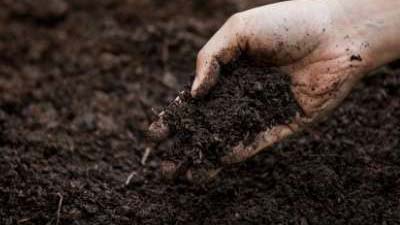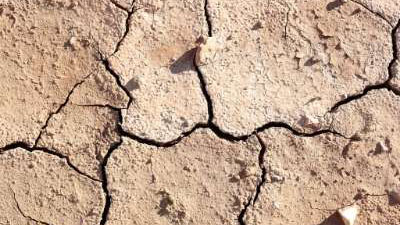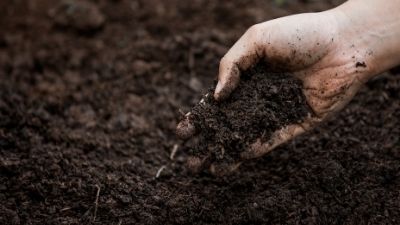Topsoil Quality Guidelines for Landscaping
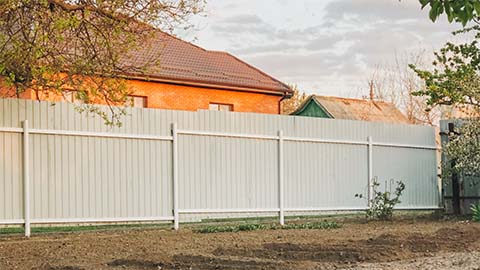
Quality topsoil is the foundation of quality landscapes. The growth rate, health and visual appearance of landscape plants are all directly related to soil quality. Quality topsoil is also a limited resource. As urban development continues, locating quality topsoil becomes more difficult and the price increases. Availability and price may also mean that marginal topsoils are used in some landscapes. This bulletin describes guidelines for topsoil and provides suggestions for homeowners, landscapers, and architects on acquiring quality topsoil.
What is topsoil?
Soil is divided into horizontal layers called horizons (Figure 1). The surface layer - the A horizon - is usually darker than the subsurface layers - the E, B and C horizons. Organic matter gives the A horizon its characteristic dark color while enhancing desirable physical properties such as tilth (ease of tillage), structure, water infiltration, and water-holding capacity. Topsoil is defined as the A horizon only, while the E, B and C horizons compose the subsoil. Subsoil horizons have higher levels of clay, salts and lime than topsoil. These properties make subsoils poor substitutes for topsoils.
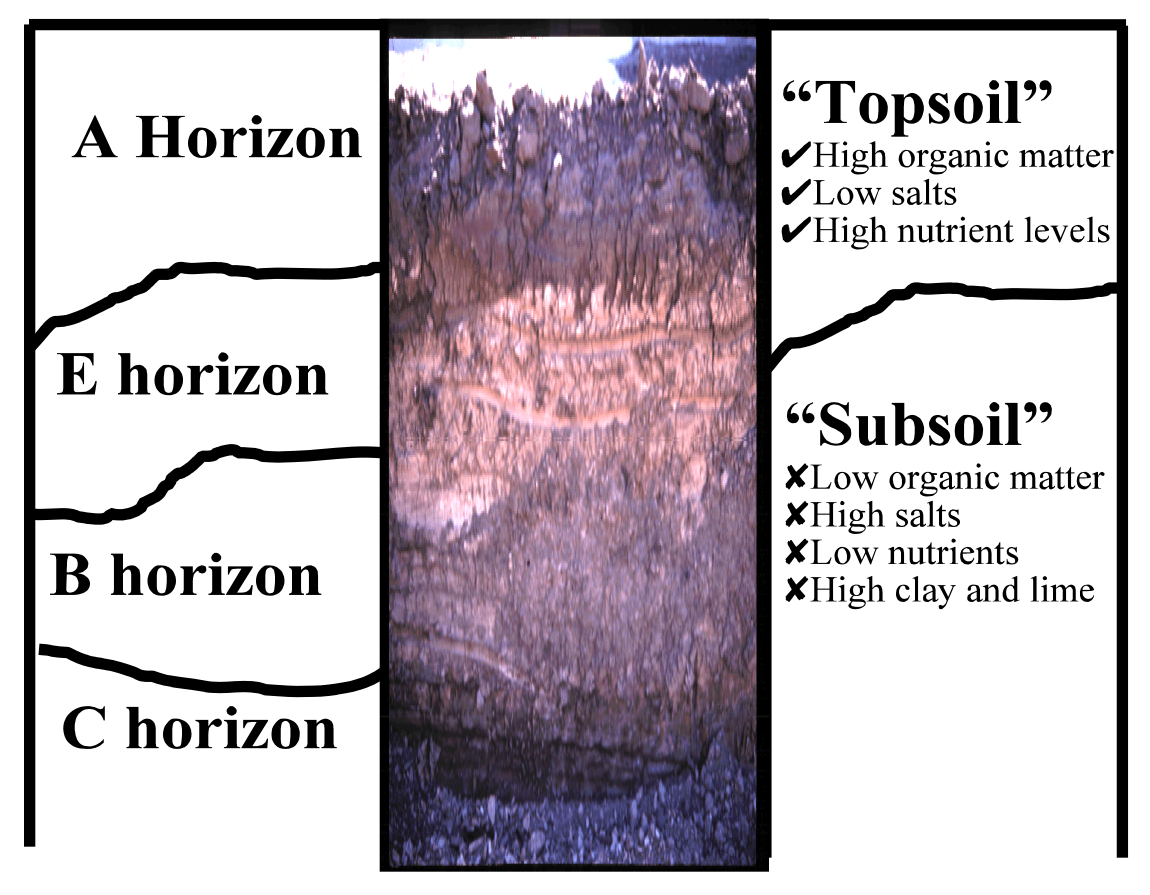
In Utah, topsoil layers commonly range from two to ten inches thick. Many materials sold as topsoils, particularly those from pits, are in fact subsoils. The true topsoil was removed from the surface of the pit in the first sale. Subsoils may be acceptable as topsoils if they are amended or otherwise treated to meet the guidelines described in this bulletin.
Topsoil quality guidelines
Several chemical and physical characteristics influence topsoil quality: soluble salts, pH, texture, organic matter, coarse fragments and nutrient content. The sodium adsorption ratio (SAR) is an additional property to consider if salinity and/or soil pH approach unacceptable levels. It is imperative that topsoil meet acceptable standards for these properties. If soil falls outside of acceptable standards for any one of the properties, reject the material or realize that considerable time and money may have to be invested to improve soil conditions before plants will thrive. The old saying “an ounce of prevention is worth a pound of cure” applies to soil. Make the effort to acquire high quality soil, even if it costs more initially. It will be less expensive in the long term than treating recurring problems or having to replace landscape plants that fail due to poor soil conditions.
The following paragraphs briefly describe important topsoil quality parameters. The table at the end of this bulletin summarizes and classifies the parameters. Soils with the Ideal classification for all of the parameters described in this guide have virtually no limitations for growing common landscape plants. Soils with the Acceptable classification may require selection of plants adapted to those conditions (e.g., high pH), or slight modification to improve soil conditions. Unacceptable soils will require major improvements before most landscape plants will survive.
Soluble salts
High levels of soluble salts make it difficult for plants to absorb water, and can have direct toxic effects on many landscape plants. Electrical conductivity of the extracted soil solution (ECe) is the measure of soluble salts. Soluble salts are removed (leached) relatively easily by applying excess, low salt water to a well drained soil. This must be done before seeding or transplanting since plants are most sensitive to salts at these times. See the related Utah State University Extension Bulletins Salinity and Plant Tolerance and Selection and Planting of Landscape Trees for more information about salinity tolerance.
pH
PH is an indication of the acidity or alkalinity (basic nature) of soil. A pH of 7.0 is neutral, while values below 7.0 are acidic and values above 7.0 are alkaline or basic. Most Utah soils have pH values in the mid-7.0 to low 8.0 range. Many plants grow well over a broad range of soil pH; however, some acid-loving plants such as blueberry, rhododendron and azalea will not grow well above pH 7. Other sensitive plants are susceptible to iron deficiency (iron chlorosis) above pH 7.5. See the related Utah State University Extension Bulletins Control of Iron Chlorosis in Ornamental and Crop Plants and Managing Soil pH in Utah for more information about iron chlorosis and soil pH.
Texture
Texture refers to the proportion (%) of sand-, silt-, and clay-sized particles in soil. The percentages by weight of sand, silt and clay are used to assign soil to a specific texture class (e.g., silt loam). Texture influences the water-holding capacity, aeration (gas exchange), drainage, tilth, and compaction and nutrient retention properties of soil. A mixture of sand, silt and clay is desirable. Soils are unacceptable if they are dominated by one particle size. It is not practical to change soil texture on a large scale. Large amounts of sand, silt or clay would be required to change soil texture, and it is difficult to incorporate this material thoroughly. Large amounts of organic matter will improve the physical characteristics of soil composed of too much sand, silt or clay.
Organic matter
Organic matter is essential in the formation of soil structure, reducing soil compaction and retaining essential plant nutrients. Generally, the higher the level of organic matter, the better the soil quality. In Utah, native soil organic matter levels are low, often less than 1 percent by weight. Soil organic matter content can be increased by adding compost, peat moss or other organic amendments.
Coarse fragments
Coarse fragments (gravel, rocks, etc.) can, if present in large amounts, make it difficult to till, seed, aerate and generally manage soil in a landscape. Construction wastes such as concrete can also contribute unacceptable coarse fragments to soil. If the percentage of coarse fragments is high the soil should be screened before use.
Sodium adsorption ratio (SAR)
The sodium adsorption ratio is a measure of the amount of sodium (an undesirable element) relative to calcium and magnesium (desirable elements) in soil. Soils with high SAR values tend to have poor structure and low water infiltration and percolation rates. Soils with a high SAR also have a high pH and/or ECe. If pH and ECe are within acceptable ranges, SAR should also be acceptable.
Nutrient concentrations
Nutrients are essential for plant growth. High quality topsoils normally have adequate phosphorus (P), potassium (K) and iron (Fe). Additional nitrogen (N) is usually required on an annual basis. If the topsoil meets these nutrient guidelines, then no additional fertilizer is needed until future soil tests indicate a deficiency.
Other considerations
Topsoil should be free from noxious weeds and weed seeds, and not previously treated with herbicides having a long residual effect. It is difficult and expensive to test for weeds and herbicides. Ask the topsoil supplier whether the material was treated to control noxious weeds and if so what the residual or planting restriction time is for the chemical used.
If possible, have soil tested to ensure that it meets acceptable chemical and physical guidelines before purchasing the material. The cost to test soil for all of the parameters described in this bulletin is approximately $25.00 to $30.00 per sample.
In some situations, importing topsoil is essential to a successful landscape. In others, the purchased soil may be no better than the resident soil on site. Before deciding to purchase new topsoil, determine whether the soil will be any better than material already on the site. If possible, have both soils tested. Compare the test results with these guidelines. Determine the cost of purchasing new topsoil and if the money is better spent improving the soil already on the site.
Qualitative indicators
There may be situations in which a soil test is not possible, or where it is desirable to make a final, visual inspection of the soil before delivery to the site. Visual appearance alone is not always a reliable indicator of soil quality. A material may look like a quality topsoil while it is unacceptable due to high salinity, pH, or other factors. The following are some qualitative characteristics to look for when inspecting a soil:
- Check for signs of salt crusting on the surface. Soils with high salinity often have light colored deposits on their surface. Do not accept a material if there is evidence of salt deposits unless the soil has been tested for salinity.
- Take a handfull of soil and attempt to crush a few dry aggregates. Ideally, dry aggregates crumble easily under pressure. Be suspicious of material that is extremely hard. Hard soils indicate low organic matter or an unacceptably high clay content. Remember that the material will behave in a similar way in the landscape.
- Wet a small sample of soil in the palm of your hand. Does a gritty (indicating high sand), smooth (indicating high silt), or sticky (indicating high clay) feeling dominate? Ideally, no one particle size or characteristic should dominate the feel. Generally, how does the material feel and behave when wet? Again remember that the material will behave in a similar way in the landscape.
- Check the color of the soil. Generally, light colored materials have lower organic matter contents than dark brown or black soils. Soils that are very light or white may contain excess salts and/or lime.
| Category | Soluble salts (dS/m or mmho/cm) | pH | Sand (%) | Silt (%) | Clay (%) | Texture class* | Organic Matter (%) | % Coarse fragments (> 2 mm in diameter)** | Sodium Adsorption Ratio (SAR)* |
|---|---|---|---|---|---|---|---|---|---|
| Ideal | < 2 | 5.5 to 7.5 | < 70 | < 70 | < 30 | L, SiL | ≥ 2.0 | ≤ 2 | < 3 for any texture |
| Acceptable | < 4 | 5.0 to 8.2 | < 70 | < 70 | < 30 | SCL, SL, CL, SiCL | ≥ 1.0 | 2.1 to 5.0 | 3 to 7 (SiL, SiCL, CL) 3 to 10 (SCL, SL, L) |
| Unnacceptable | > 4 |
< 5.0 or |
> 70 | > 70 | > 30 | LS, SC, SiC, S, Si, C | < 1.0 | > 5.0 | > 10 for any texture |
*L = loam; SiL = Silt loam; SCL = sandy clay loam; SL = sandy loam; CL = clay loam; SiCL = silty clay loam; LS = loamy sand; SC = sandy clay; SiC = silty clay; S = sand; Si = silt; C = clay.
**This guideline also includes no fragments larger than 1 ½ inch in diameter.
| Category | Nitrate-nitrogen (ppm or mg N/kg soil) | Phosphorus (ppm or mg P/kg soil) | Potassium (ppm or mg K/kg soil) | Iron (ppm or mg Fe/kg soil) |
|---|---|---|---|---|
| Acceptable | > 20 | > 15 | > 150 | > 10 |
Published December 2010
Utah State University Extension
Peer-reviewed fact sheet
Download PDF
Authors
Rich Koenig, Utah State University Extension Soil Specialist, and Von Isaman, QA Consulting and Testing, LLC
Related Research



